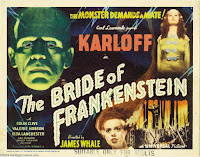Adapted and updated
from Mary Shelley’s story, Dr. Frankenstein puts together a being from dead
human tissue, only to reject it after he is successful. Mistreated by (almost) a
variety of, the ‘monster’ becomes an angry outcast tracked down by the city.
Besides
Karloff’s still-sympathizing ‘monster,’ the film gives wonderful Gothic sets, a
great laboratory, Whale’s covertly camp scaffold humor, a torch-lit peasant mob
and many other images that are remembered to this day.
Special
note: the digitally remastered version has a thundercrack over the
often-censored “Now I know what it feels to be God” line, but is otherwise
completely restored, complete with footage not seen for many years where the
monster accidentally drowns a little girl.
Beautiful
photography, a sad story, and iconic moments from beginning to end, this film
needs to be seen by all.
What
followed was a sequel that a lot of people want to say is superior, “Bride of
Frankenstein,” released in 1935.
Nowadays,
it’s not uncommon that a popular film will get some type of sequel. In 1931,
when James Whale’s “Frankenstein” was hitting it large with box office records
and establishing Universal Studios as a huge company, the rules didn’t really
apply. The studio wasn’t really sure how this laconic British director had made
such a massive, groundbreaking horror movie at all. Since he was evidently
hitting it large with “The Invisible Man” and “The Old Dark House,” the studio
let him have full reign with the sequel as he wanted.
“Bride
of Frankenstein” is a great movie, even today. Phelim O’Neill stated in his
review, “It flits between the classical and the gutter, the camp and the
serious in a manner that's hard to pin down.” Boris Karloff reprises the role
of the monster, this time with dialogue (audiences would not have expected
less), and Colin Clive returns as the Doctor, recast by Whale for his unique “hysterical
quality,” even though his alcoholism got worse.
O’Neill
noted, “What the audience wouldn't or couldn't have anticipated was Ernest
Thesiger's wonderfully fey and flamboyant Dr Septimus Pretorius (the studio
wanted – but didn't get – Claude Rains), and his experimental royal family of
homunculi, and Elsa Lanchester in her vertical hairdo, complete with bleached
lightning bolts.” Whale gave audiences what they wanted, even if they didn’t
know it themselves.
This
first non-James Whale Frankenstein film has a lot going for it, other than its
amazing cast. The impressive art direction takes advantage of the better look
and film stocks available since the last movie came out four years prior. Erickson
said, “The combination sulphur pit - laboratory is splendidly atmospheric, with
its steam and dark lighting. The cracked-egg appearance of the lab exterior (a
nice matte painting) is also unique.”
The
story this time around is pretty straightforward, not really going up to the chilling
heights of the last movie, by managing its own kind of insanity. Erickson said,
“Lugosi's Ygor character has a creepy pied-piper quality and interacts well
with Karloff's monster. After the speaking, active monster of the previous
film, Karloff's mute and slow-witted interpretation this time around has
disappointed a lot of Universal fans; from this point on the Monster would
almost always be portrayed as a hulking automaton.” However, the level of
emotions and expression hasn’t really left. Karloff just slanted his playing to
match the script’s new style.
Erickson
said, “The closest I have to knowledge of how these pictures were received when
new, comes from my mother, who remembers her first date being to go see this
movie with a reissue of Dracula. At age 16 she was terrified and hasn't cared
to see a horror film since. What they saw in 1939 was perhaps the last
Universal Horror film intended to have real gravity instead of being a popcorn
movie. Rathbone's dialogue is so well written and delivered, you'd think the
gobbledegook he was spouting about internal medicine were real.” Ygor’s
relationship with the Monster has some weight instead of being filler between
action scenes, and the time and effort are given to emotional little setpieces
such as when the nanny notices that the door to the nursery is closing by
itself, very slowly.
The
first movie is the most classic, the second movie is the most emotional, and
the third movie is most well-written, but you can debate about that. I can’t
decide which one of these I like the most, so let’s just say this trilogy is a
three-way tie. These are three of my favorite films and I can’t do these films justice,
so just watch these movies to know.
There
is my first review, look out Friday for the next installment of this year’s “Halloween
Month.”



No comments:
Post a Comment